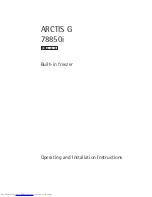
GB
33
Helpful hints and tips
Cleaning and care
Noises from the appliance
Clicks -
Whenever the compressor switches on or off, a
click can be heard.
Humming -
As soon as the compressor is in operation, you
can hear it humming.
Bubbling -
When refrigerant flows into thin tubes, you can
hear bubbling or splashing noises.
Splashing -
Even after the compressor has been switched
off, this noise can be heard for a short time.
Energy-saving tips
Do not install the appliance near stoves, radiators or other
sources of warmth.
Keep the time the appliance is open to a minimum.
Do not set the temperature colder than necessary.
Make sure there is clearance between the sides and
rear of the appliance and the wall and follow the relevant
installation instructions.
If the illustration shows the recommended configuration
of the drawers, crisper and shelves do not change this
configuration as it will lead to increased energy use.
Tips for freezing
When first starting up or after a period out of use: before
putting the food in the compartment, let the appliance run for
at least 2 hours at a higher setting.
Prepare food in small portions so that it can be rapidly and
completely frozen and so that you only need to thaw the
quantity required.
Wrap up food in aluminum foil or polythene (plastic) and
make sure that packages are airtight.
Do not allow fresh, unfrozen food to touch food that is
already frozen, to avoid raising the temperature of the latter.
If frozen ice products are eaten immediately after removal
from the freezer compartment they may cause freezer burns
to the skin.
It is recommended to mark the date of freezing on each
frozen package so that you can keep track of the storage
time.
Tips for storing frozen food
Make sure that commercially frozen food is stored according
to the manufacturer’s recommendations.
Once defrosted, foods deteriorate rapidly and cannot be
re-frozen.
Do not exceed the storage period indicated by the food
manufacturer.
Note:
lf the appliance has related accessories and
functions.
Cleaning and care
For hygienic reasons, the appliance interior, including
interior accessories, should be cleaned regularly.
The appliance should be cleaned and maintained at least
every two months.
Warning! Danger of electrical shock!
The appliance should not be plugged in during cleaning.
Before cleaning, switch off the appliance and unplug it from
the power socket, or switch off or remove the circuit breaker
or fuse.
Notice!
Remove the food from the appliance before cleaning. Store
it in a cool place and keep well covered.
Never clean the appliance with a steam cleaner. Moisture
could accumulate in electrical components.
Hot vapour can damage plastic parts.
Essential oils and organic solvents can attack plastic parts,
e.g. lemon juice or the juice from an orange peel, butyric
acid, or cleansers that contain acetic acid. Do not allow such
substances to come into contact with appliance parts.
Do not use any abrasive cleansers.
Clean the appliance and the interior accessories with a cloth
and lukewarm water. Commercially available dish washing
detergents may also be used.
After cleaning, wipe with fresh water and a clean dish cloth.
Dust that settles on the condenser increases energy
consumption; clean the condenser at the back of the
appliance once a year with a soft brush or a vacuum
cleaner. (Only applies to appliances with an external
condenser.)
Check the water drain hole on the rear wall of the
refrigerator compartment.
If the drain hole is blocked, clean it with the aid of something
like a soft peg, taking care not to damage the cabinet with
sharp objects.
After everything is dry, reconnect and turn on the appliance.
Defrosting
Defrosting the frozen food storage compartment
The freezer compartment must be defrosted manually.
Remove the food before defrosting.
Take the ice tray and drawers out or put them into the fresh
food compartment temporarily.
Leave the door of the appliance open until ice and frost melt
completely and accumulate at the bottom of the freezer
chamber. Wipe out the water with a soft cloth.
To speed up the defrosting process you can put a bowl of
warm water (about 50°C) into the freezer compartment and
scrape away the ice and frost with a defrosting spatula. After
doing so, be sure to set the temperature regulator knob to
the original position.








































